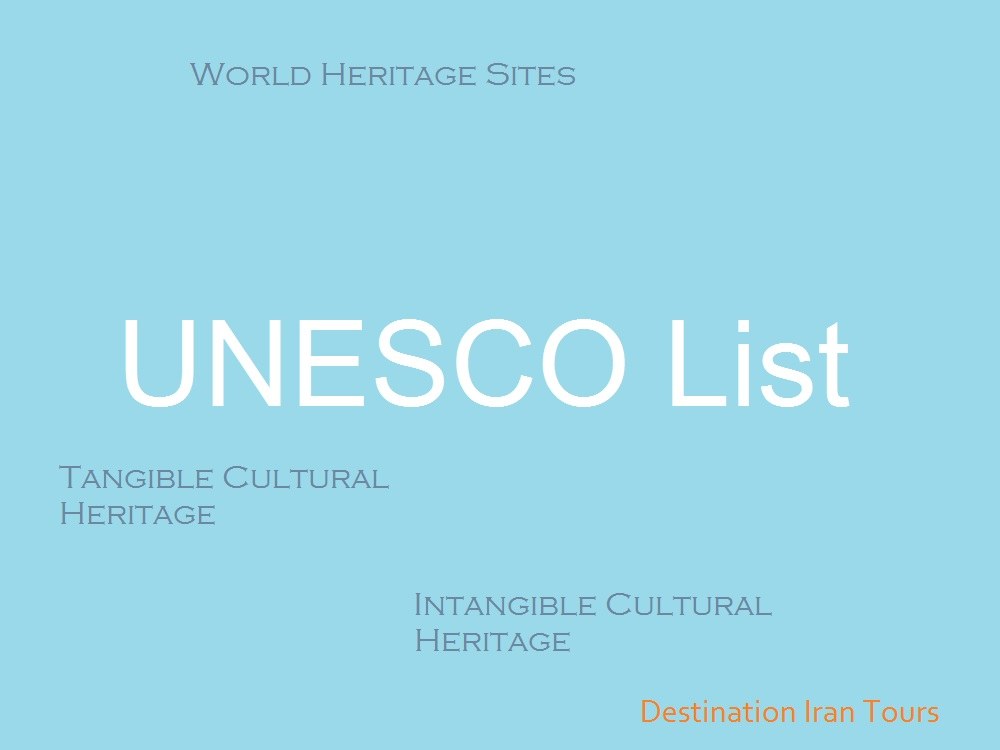
UNESCO List is a major reference as a universally recognized source of World Cultural Heritage. It covers tangible and intangible cultural heritage properties and elements among other entities. Iran has got several already inscribed there and many more on the waiting list.
The United Nations Educational, Scientific and Cultural Organization (UNESCO) selected the tangible and intangible cultural heritage of all nations and inscribes them as entities having the cultural, historical, scientific or other forms of significance. So, UNESCO makes lists of such legacies of each nation under two major lists recognized globally.
Iran, as an ancient country in the Middle East, is the home to a huge number of such legacies. Iranian Cultural Heritage, Handicrafts, and Tourism Organization (ICHHTO) is the official body for the registration and preservation of cultural heritage in Iran. Some of them are historical sites and some are cultural rituals, customs, traditions, skills, etc. They are inherited from our ancestors since several centuries ago.
In order to get to know UNESCO list of tangible and intangible cultural heritage, it’s best to quickly review cultural heritage first. All communities in the world have inherited certain lifestyle and monuments form their forefathers. Such lifestyle includes movable instances like indigenous and national rituals and traditions, skills and related crafts, religious convictions, arts, literature, and all the remained valuables. The monuments include immovable instances like historical buildings, structures, etc.
Iranian Tangible Cultural Heritage in UNESCO List
The Iranian World Heritage Sites listed by UNESCO cover a wide range of various types of properties from examples of engineering, architecture, city planning, etc to bazaars, sets of buildings, etc. The UNESCO list includes:
- Sassanid Archaeological Landscape of Fars Region (2018)
- Historic City of Yazd (2017)
- The Persian Qanat (2016)
- Susa (2015)
- Cultural Landscape of Maymand (2015)
- Shahr-i Sokhta (2014)
- Golestan Palace (2013)
- Gonbad-e Qābus (2012)
- Masjed-e Jāmé of Isfahan (2012)
- The Persian Garden (2011)
- Tabriz Historic Bazaar Complex (2010)
- Sheikh Safi al-din Khānegāh and Shrine Ensemble in Ardabil (2010)
- Shushtar Historical Hydraulic System (2009)
- Armenian Monastic Ensembles of Iran (2008)
- Bisotun (2006)
- Soltaniyeh (2005)
- Pasargadae (2004)
- Bam and its Cultural Landscape (2004)Pasargadae (2004)
- Takht-e Soleyman (2003)
- Persepolis (1979)
- Tchogha Zanbil (1979)
- Meidan Emam, Esfahan (1979)
This UNESCO list covers several World Heritage Sites that are sources of pride for Iranian and attract many enthusiastic world travelers every year to Iran. They are interested in learning about the history and culture of Iran.
To learn about each of the above in details, please go to the Tangible Cultural Heritage of Iran!
Also, you can find them on UNESCO’s website!
Iranian Intangible Cultural Heritage in UNESCO List
According to national and international definitions, intangible cultural heritage refers to the particular behavior, symbols, skills, means, indigenous knowledge and know-how, handicrafts and cultural spaces of a nation. They are handed over from a generation to the next.
Iranian intangible cultural heritage includes performing arts, traditional and hand-made crafts, skills associated with traditional and hand-made crafts, social traditions, customs, festivities and rituals, science and customs associated with nature and world, verbal traditions and other manifestations like languages and dialects. The UNESCO list includes:
- Traditional skills of crafting and playing Dotār (2019).
- Art of crafting and playing with Kamancheh/Kamancha (2017)
- Chogān, a horse-riding game accompanied by music and storytelling (2017)
- Flatbread making and sharing culture: Lavash, Katyrma, Jupka, Yufka (2016)
- Nowrouz (2016)
- Qālišuyān rituals of Mašhad-e Ardehāl in Kāšān (2012)
- Naqqāli, Iranian dramatic story-telling (2011)
- Traditional skills of building and sailing Iranian Lenj boats in the Persian Gulf (2011)
- Music of the Bakhshis of Khorasan (2010)
- Pahlevani and Zoorkhanei rituals (2010)
- Ritual dramatic art of Ta‘zīye (2010)
- Traditional skills of carpet weaving in Fars (2010)
- Traditional skills of carpet weaving in Kashan (2010)
- Radif of Iranian music (2009)
Of course, a lot more is on the waiting section of the UNESCO list or at the documentation process in ICHHTO. They will be introduced to the world sooner or later.
To learn about each of the above in details, please go to the Intangible Cultural Heritage of Iran!
Also, you can find them on UNESCO’s website!








I think when Muslims must visit Qabah once in their life time, people of the world should visit Iran once in their life time. This is the land of their anscestors. They will find their own roots here.
I invite everyone to come home, to the land of their grand parents.
Amir Arbaban
I have been to a couple of countries , but I have never tasted a food as delicious as Kebab, the traditionally cooked meat on screw . Never forget to ask for Bonabi Kebab , it is very special also dont forget to ask for Iranian souvenir
Qom’s SOHAN , Tabriz’s NOGHA , Isfahani GAZ ,Yazd BAGHLAVA and Bonab’s Kebab
Iran is a beautiful country with a lot of tourist attractions that invites you every time!dont give up this chance!
In addition to all the unique characteristics , Iran has a four seasoned climate. In any time of the year you could travel from winter of the north to the spring of the south. and at the hot summer of the south , to the beautiful climate of the north and enjoy such a fantastic place as well . Iran has a history backed to the thousands years , and it is recommended for all to visit such a paradise at least once in their life .
can you give a breif introduction about iran and its history concerning the topic ! thx!